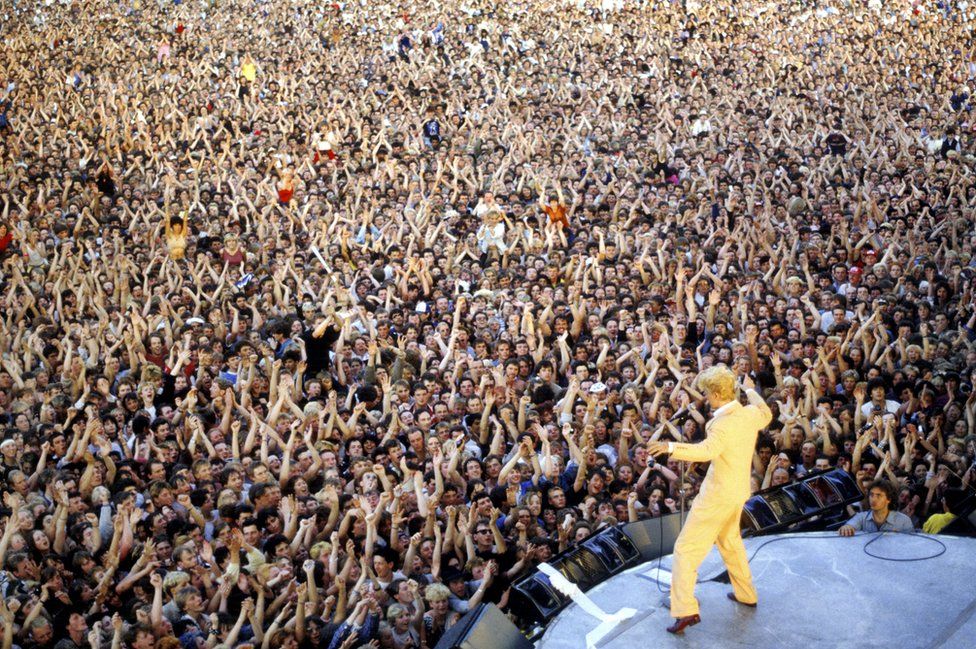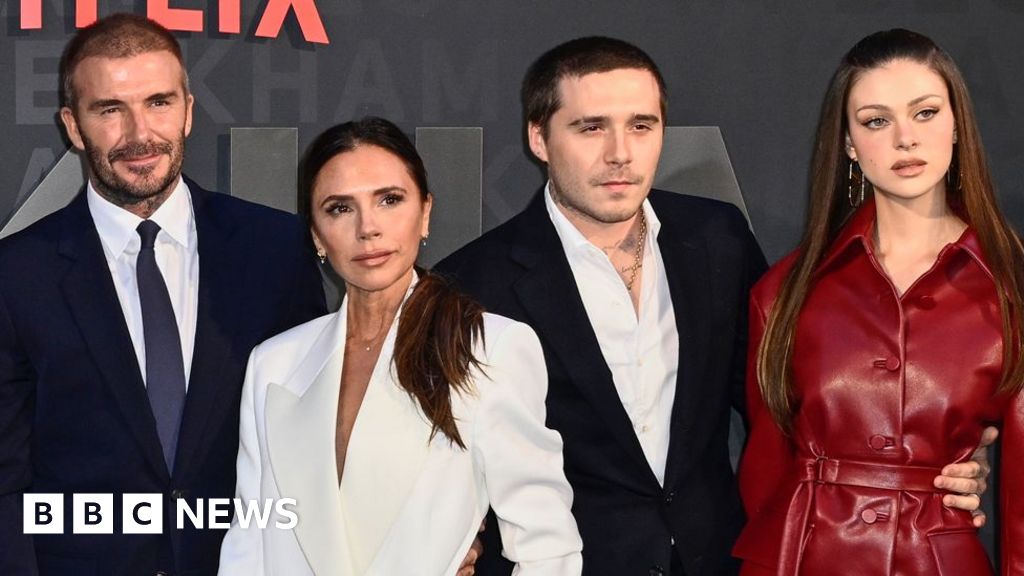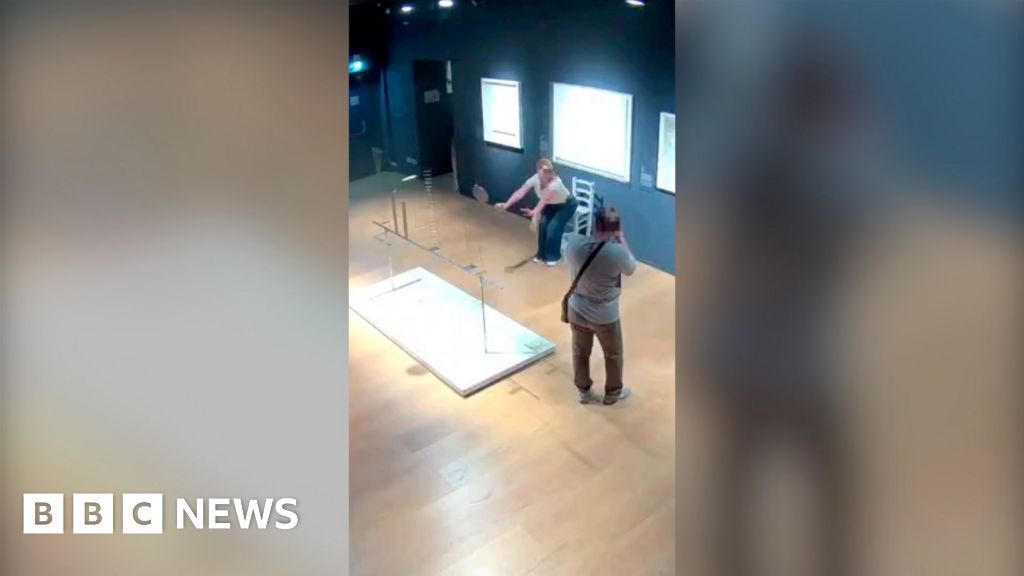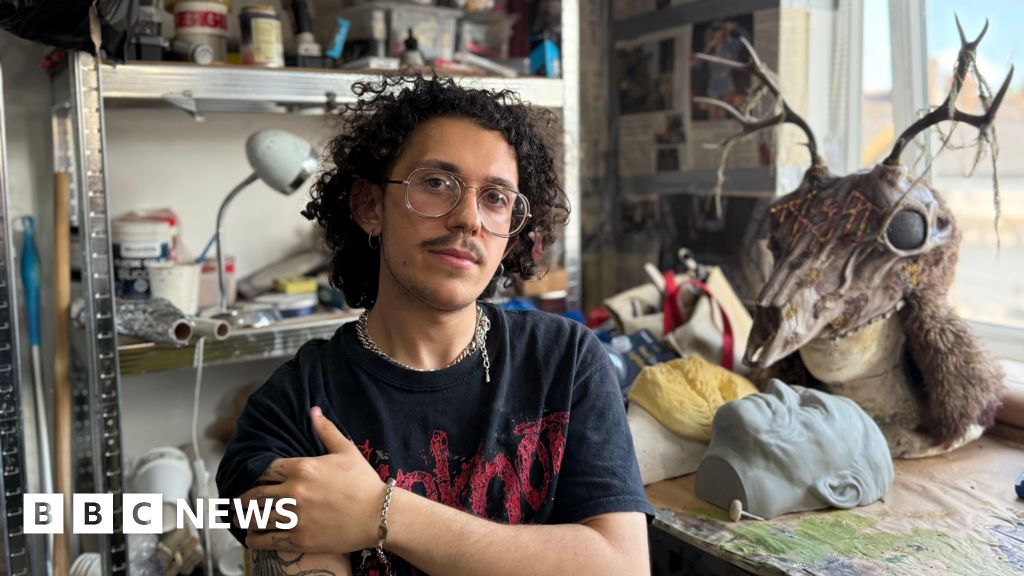ARTICLE AD BOX
 Image source, Denis O'Regan
Image source, Denis O'Regan
Denis O'Regan climbed behind the star to create his iconic image of Bowie at the Milton Keynes Bowl
By Vanessa Pearce
BBC News, Buckinghamshire
Forty years ago this weekend tens of thousands of fans gathered to watch David Bowie play three nights at a converted clay pit in the Buckinghamshire countryside. Fans who witnessed the gigs, from front and back of stage, spoke to the BBC about their memories.
They came in their thousands from all across the country - with extra train services and coaches laid on to deal with the demand.
More than 150,000 descended on the National Bowl in Milton Keynes that sweltering weekend in July 1983, on a tour that saw Bowie play his first live gigs in England in five years.
I was among them. My journey, aged 15 and accompanied by a school friend, was on a coach from Cornwall. I didn't know it then, but we were about to witness the artist's transformation to a new level of global superstar.
Alongside the die-hard Bowie fans, ska and reggae lovers had turned out to see support act The Beat, joining new romantics, punks and even a contingency of Hell's Angels, from memory. Bowie's new persona seemed to appeal to everyone, and it felt like half the country was there.
The three dates, from 1 to 3 July, had been added to the end of the European leg of his Serious Moonlight tour, due to massive demand for tickets following the success of the Let's Dance album and its hit singles, including the title track.
The nine-month tour had "snowballed", said official photographer Denis O'Regan, eventually featuring 99 dates in over 60 cities across the globe, including a series of massive open-air concerts.
Image source, Denis O'Regan
Image caption,Denis O'Regan pictured with David Bowie in Singapore during the tour
The photographer said he had been inspired to work with Bowie after seeing him a decade earlier at the famous Hammersmith Odeon concert, the night before the Bowie retired his Ziggy Stardust incarnation.
"That gig really changed my whole life," he said.
"I decided I wanted to go on tour with David Bowie, I also wanted to tour with the Rolling Stones, because they were the biggest band and I wanted to tour with Queen, because they were great, and I ended up touring with them all.
"I approached David with a business plan to produce a book of the tour, which he really liked."
An early assumption the artist would keep him at arms length, being protective of his image, turned out to be the opposite, he explained.
"He was a very, very warm person and wanted to engage really easily with what I was doing, wanting me to cover every moment."
His photographs document the transformation of the artist "from the inside", he said, "it was an amazing time to be with him."
Image source, Denis O'Regan
Image caption,Bowie, who died in 2016, was known for radical changes of image during a career that included five number one singles in the UK as a solo artist and with collaborations
Image source, Denis O'Regan
Image caption,Bowie had played arena gigs in London and Birmingham earlier in the tour, but the Milton Keynes shows offered a chance for thousands more British fans to see him
As the tour progressed the photographer said he had to come up with different ways of shooting the star "to hold David's interest".
"If it was a shot of the live performance, it had to be very special," he said.
"At Milton Keynes, instead of the audience disappearing over the horizon they rise up in front of you, and that's what gave it that epic look."
The resulting images were featured in US magazines Newsweek and Time "and of course gave this impression of David being an enormous star playing to huge crowds so that really had quite an effect," he said.
"The rest of the world, especially America where David wasn't so big, saw this all happening and suddenly they wanted him, because they were booking into stadiums as well, so the tour took on a different level of magnitude and became a huge thing."
Image source, Denis O'Regan
Image caption,O'Regan said his access to Bowie relaxing or backstage was "way beyond what I ever expected"
An 18-year-old Chris Wilson had driven from Norfolk with friends for the first of the three dates, the day after finishing his A level exams.
"The day is still singed on my memory; we had pictures of Bowie stuck in the windows in the back of the car; that's how excited we were," he said.
"My god, he was on form and just looked amazing. He was shining and golden, the staging was magical.
"I just remember it being utterly euphoric because we'd waited so long to see him.
"His genius was, even in a massive crowd like that, you felt like he was singing to you, he was looking at you."
Image source, Denis O'Regan
A Manchester University student at the time, Dr Joan Keating said she had gone to the gig with friends as birthday treat.
"I made a strapless dress out of yellow broderie anglaise and wore it with elbow length white lace gloves," she said.
"I remember that Bowie was very far away from the section that we were in, but that I felt grown up and glamorous and somehow in exactly the place that I was meant to be as a 20-year-old textiles student.
"I can still 'feel' the music."
Image source, Denis O'Regan
Image caption,Bowie with Mick Jagger and Jerry Hall in New York. Bowie and Jagger went on to have a UK number one single with Dancing In The Streets in 1985
To a 16-year-old Nick De Marco, attending the gig with school friends from London had felt like a "big expedition".
"There were so many tens of thousands of people ahead of us, and all being young kids we didn't really think of getting to the front, but it was all very exciting," he said.
"But it is incredible when you do see the pictures of the enormity of that gig, and you just think, god, I was in there somewhere."
Like many of us he also remembered the slow train journey back to London, arriving at Euston in the early hours.
"There was no way we could get home, so we all just slept on the concourse, it was full of hundreds of people doing the same thing," said Mr De Marco, who is now a lawyer.
"It was like there had been an earthquake or something."
A 15-year-old Sam Rosser had travelled from Staffordshire for the gig, and said she felt "slightly hysterical" at times.
"I will never, ever forget that day, ever. I feel so lucky to have had that experience. I miss him so much."
Image source, Denis O'Regan
Image caption,Bowie had had a solo UK number one single in 1980 with Ashes To Ashes, but the Let's Dance album took him to an even higher level of commercial success
Dave Willis, then 17 years old and living in Woking in Surrey, describes phoning in sick to his employers in order to go to the concert with a colleague.
"Being provincial boys, we used to go to civic halls and leisure centres to see bands, so the thought of going to this great big bowl to see Bowie, and The Beat was just great," he said.
"It was so hot and of course we hadn't taken anything with us - we just got there and got down the front and then had to stay there, so we just spent all day in the sun with nothing to drink.
"I remember everything just being brilliant; every act was on point, and he came on and just blew everyone away."
Image source, Denis O'Regan
Image source, Denis O'Regan
O'Regan now has a gallery in Hammersmith in west London, where he exhibits and sells limited edition prints and his published photography books, and looks back with great fondness at the time he spent with Bowie.
"On the tour we would have a slide show in my room once I got the pictures developed [as used to happen with rolls of camera film], and I really used to enjoy that," he said.
"I used to love it just me and David, and we often used to go out just me and him.
"It was way beyond what I ever expected. I knew at the time how lucky I was."
Ricochet: David Bowie 1983, Denis O'Regan's deluxe box set including five books, signed and numbered prints, and exclusive vinyl, will soon be available to buy individually in unboxed collections.
As the person who has photographed Bowie more than anyone, O'Regan is also working on a new book detailing his photographs of the artist across a 20-year period.
Follow East of England news on Facebook, Instagram and Twitter. Got a story? Email eastofenglandnews@bbc.co.uk or WhatsApp us on 0800 169 1830
The BBC is not responsible for the content of external sites.

 1 year ago
36
1 year ago
36








 English (US) ·
English (US) ·